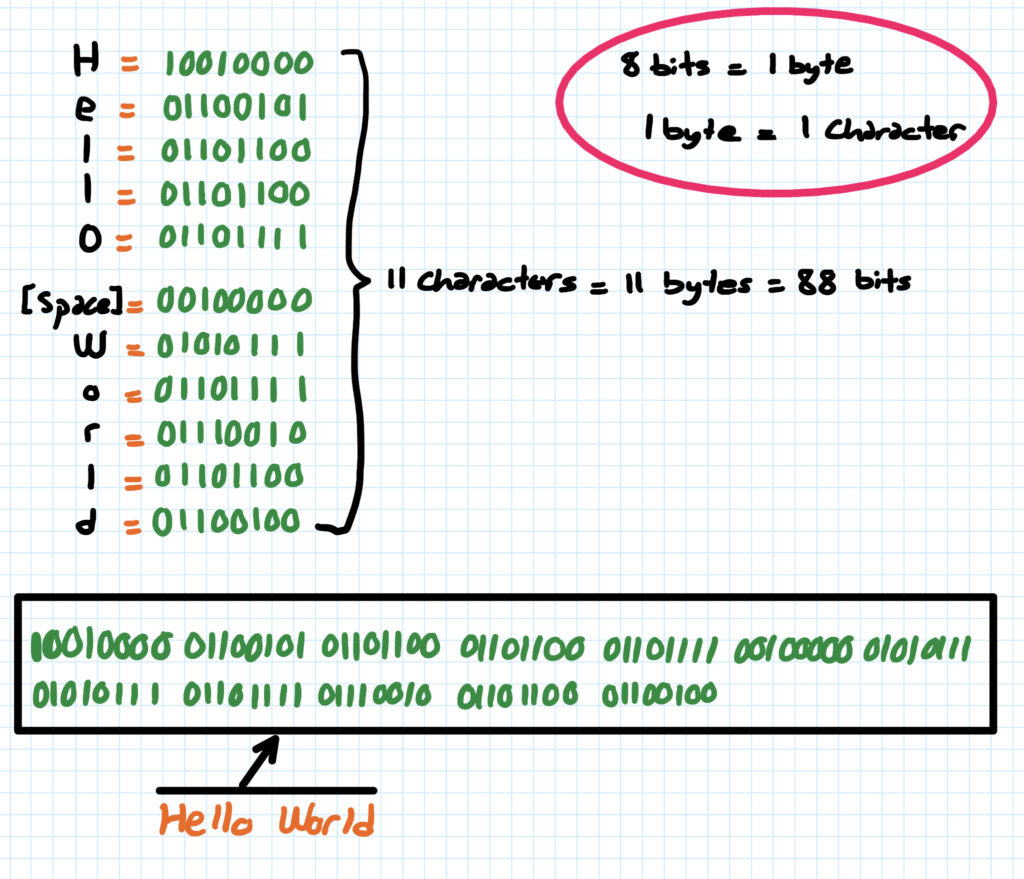This is an example of text converted to Binary code and hexadecimal. Each letter even space ( binary representation 00100000) between words is represented with 8-bit binary code(ASCII code).
There are 151 characters in the following Sample Text.
151 characters = 151 bytes
so 1 character(letters, numbers, spaces etc) is equal to 1 byte.
More details about ASCII table and binary representation, read the following post.
Sample Text
Lorem ipsum dolor sit amet, consectetur adipiscing elit. Ut eu felis augue. Sed non ante arcu. Sed pulvinar erat augue, ut volutpat est congue lacinia.
Sample Text to Binary
01001100 01101111 01110010 01100101 01101101 00100000 01101001 01110000 01110011 01110101 01101101 00100000 01100100 01101111 01101100 01101111 01110010 00100000 01110011 01101001 01110100 00100000 01100001 01101101 01100101 01110100 00101100 00100000 01100011 01101111 01101110 01110011 01100101 01100011 01110100 01100101 01110100 01110101 01110010 00100000 01100001 01100100 01101001 01110000 01101001 01110011 01100011 01101001 01101110 01100111 00100000 01100101 01101100 01101001 01110100 00101110 00100000 01010101 01110100 00100000 01100101 01110101 00100000 01100110 01100101 01101100 01101001 01110011 00100000 01100001 01110101 01100111 01110101 01100101 00101110 00100000 01010011 01100101 01100100 00100000 01101110 01101111 01101110 00100000 01100001 01101110 01110100 01100101 00100000 01100001 01110010 01100011 01110101 00101110 00100000 01010011 01100101 01100100 00100000 01110000 01110101 01101100 01110110 01101001 01101110 01100001 01110010 00100000 01100101 01110010 01100001 01110100 00100000 01100001 01110101 01100111 01110101 01100101 00101100 00100000 01110101 01110100 00100000 01110110 01101111 01101100 01110101 01110100 01110000 01100001 01110100 00100000 01100101 01110011 01110100 00100000 01100011 01101111 01101110 01100111 01110101 01100101 00100000 01101100 01100001 01100011 01101001 01101110 01101001 01100001 00101110Binary to Hexadecimal
4C 6F 72 65 6D 20 69 70 73 75 6D 20 64 6F 6C 6F 72 20 73 69 74 20 61 6D 65 74 2C 20 63 6F 6E 73 65 63 74 65 74 75 72 20 61 64 69 70 69 73 63 69 6E 67 20 65 6C 69 74 2E 20 55 74 20 65 75 20 66 65 6C 69 73 20 61 75 67 75 65 2E 20 53 65 64 20 6E 6F 6E 20 61 6E 74 65 20 61 72 63 75 2E 20 53 65 64 20 70 75 6C 76 69 6E 61 72 20 65 72 61 74 20 61 75 67 75 65 2C 20 75 74 20 76 6F 6C 75 74 70 61 74 20 65 73 74 20 63 6F 6E 67 75 65 20 6C 61 63 69 6E 69 61 2E